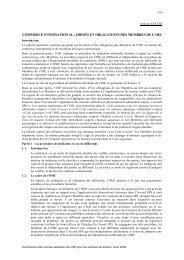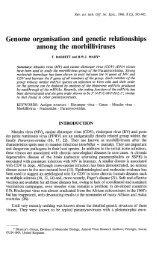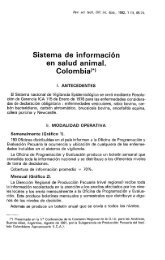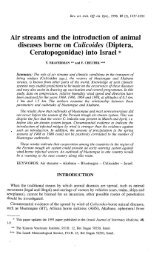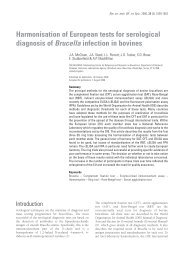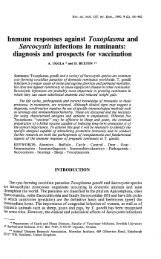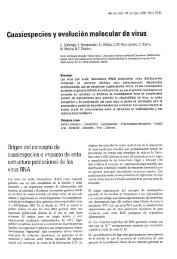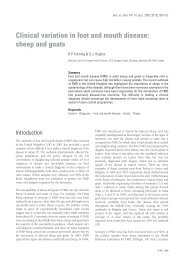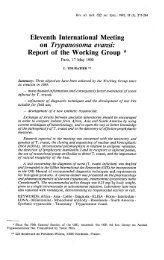26th Conference of the OIE Regional Commission for Asia
26th Conference of the OIE Regional Commission for Asia
26th Conference of the OIE Regional Commission for Asia
You also want an ePaper? Increase the reach of your titles
YUMPU automatically turns print PDFs into web optimized ePapers that Google loves.
Table 4. Simulation exercises per<strong>for</strong>med in <strong>Asia</strong>, <strong>the</strong> Far East and Oceania in 2008 and 2009<br />
<strong>OIE</strong> Member Scope <strong>of</strong> <strong>the</strong> exercise Dates<br />
Australia Foot and mouth disease 31 July to 12 November 2009<br />
United States <strong>of</strong> America Foot and mouth disease and anthrax 18 to 24 June 2009<br />
United States <strong>of</strong> America-<br />
Canada Foot and mouth disease 16 to 19 June 2009<br />
United States <strong>of</strong> America Rift Valley fever 18 to 20 November 2008<br />
Australia Classical swine fever 18 to 20 November 2008<br />
Australia Avian influenza 11 and 12 November 2008<br />
Australia Foot and mouth disease 29 and 30 October 2008<br />
Australia Swine disease 21 and 22 October 2008<br />
Singapore Highly pathogenic avian influenza 10 January 2008<br />
146. In its report <strong>for</strong> this <strong>Regional</strong> <strong>Conference</strong>, Bhutan in<strong>for</strong>med <strong>the</strong> <strong>OIE</strong> <strong>of</strong> national simulation<br />
exercises <strong>for</strong> an HPAI outbreak (table top exercise and field simulation). Details <strong>of</strong> <strong>the</strong><br />
simulation exercises could not be distributed through <strong>the</strong> <strong>OIE</strong> distribution list since <strong>the</strong>y were<br />
not received at <strong>the</strong> <strong>OIE</strong> Headquarters in time. To in<strong>for</strong>m <strong>the</strong> <strong>OIE</strong> <strong>of</strong> a <strong>for</strong>thcoming simulation<br />
exercise, <strong>OIE</strong> Delegates are requested to send details by email to <strong>the</strong> <strong>OIE</strong> Animal Health<br />
In<strong>for</strong>mation Department (in<strong>for</strong>mation.dept@oie.int). This will ensure that <strong>the</strong>re is sufficient<br />
time to retransmit <strong>the</strong> in<strong>for</strong>mation via <strong>the</strong> <strong>OIE</strong> distribution list.<br />
147. The <strong>OIE</strong> has also asked all Members to share <strong>the</strong>ir contingency plans by posting <strong>the</strong>m on <strong>the</strong><br />
<strong>OIE</strong> Web site. The <strong>OIE</strong> renews its request to Members in <strong>Asia</strong>, <strong>the</strong> Far East and Oceania to<br />
send <strong>the</strong>ir new contingency plans to <strong>the</strong> <strong>OIE</strong> if <strong>the</strong>y are in one <strong>of</strong> <strong>the</strong> <strong>OIE</strong>’s <strong>of</strong>ficial languages.<br />
148. Bhutan has prepared a National Influenza Pandemic Preparedness Plan, updated in October<br />
2008, which includes training <strong>of</strong> trainers and <strong>of</strong> field staff, simulation exercises, and<br />
preparation <strong>of</strong> standard operating procedures <strong>for</strong> HPAI outbreaks.<br />
149. The China State Council has <strong>for</strong>mulated a “Regulation on Major Animal Diseases Emergency<br />
Response” and a “National Contingency Plan <strong>for</strong> Major Animal Disease Outbreaks”.<br />
150. India indicates that contingency plans are developed from time to time to tackle diseases<br />
which are emerging or exotic. The Government <strong>of</strong> India developed a contingency plan on<br />
‘Preparedness, Control & Containment <strong>of</strong> Avian Influenza in India’ in 2005, which was<br />
subsequently revised in 2006 and is again under revision on <strong>the</strong> basis <strong>of</strong> <strong>the</strong> experience gained<br />
in tackling outbreaks in backyard poultry.<br />
151. Iraq has a contingency plan <strong>for</strong> rinderpest disease, which was included with <strong>the</strong> application<br />
submitted to <strong>the</strong> <strong>OIE</strong> <strong>for</strong> recognition <strong>of</strong> freedom from <strong>the</strong> disease, and a contingency plan <strong>for</strong><br />
avian influenza prepared by <strong>the</strong> Department <strong>of</strong> Epidemiology. The latter plan is currently<br />
being implemented and updates are made as and when necessary.<br />
152. The Government <strong>of</strong> Maldives has developed a national contingency plan <strong>for</strong> HPAI. A National<br />
Committee on Bird Flu Prevention and Control was constituted and has been operational since<br />
September 2005. The contingency plan is reviewed whenever new guidelines become available<br />
and now <strong>for</strong>ms <strong>the</strong> basis <strong>for</strong> H1N1 influenza preparedness.<br />
153. A contingency plan <strong>for</strong> <strong>the</strong> control <strong>of</strong> HPAI in Myanmar was published in 2005 be<strong>for</strong>e <strong>the</strong><br />
country’s first outbreak <strong>of</strong> HPAI. This contingency plan was revised in 2007 and 2008 to meet<br />
<strong>the</strong> update requirements. The plan covers several topics, such as international policies and<br />
cooperation on HPAI, <strong>the</strong> occurrence <strong>of</strong> avian influenza in <strong>Asia</strong> and Pacific, climatic conditions,<br />
inspection teams <strong>for</strong> <strong>the</strong> control <strong>of</strong> avian influenza, control measures, surveillance and<br />
diagnostic capabilities, vaccination, public awareness and financial assistance.<br />
23





